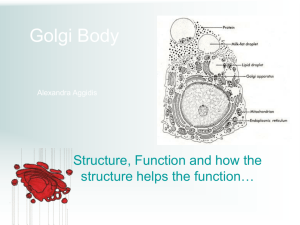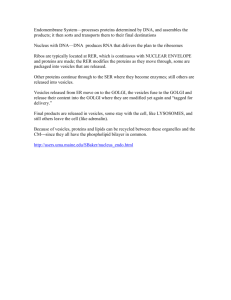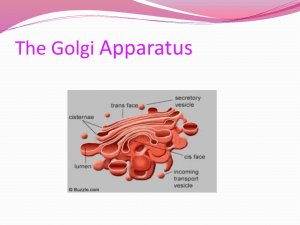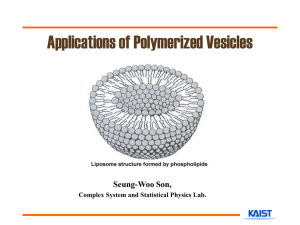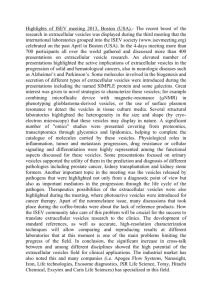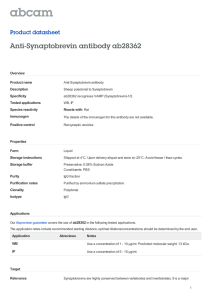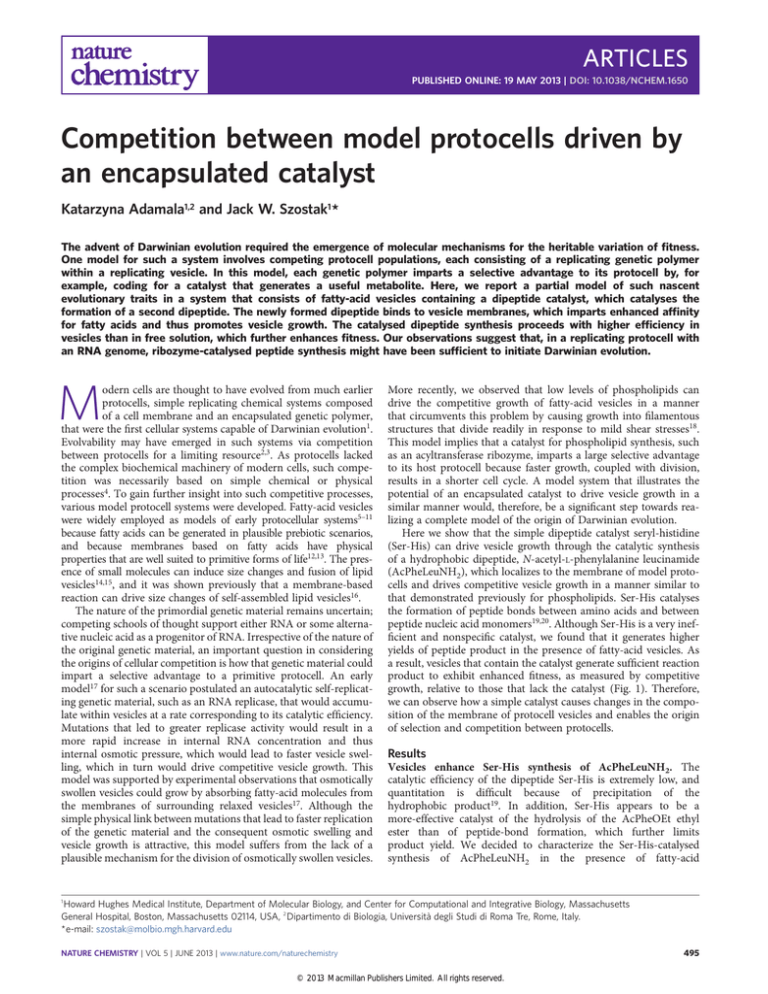
ARTICLES
PUBLISHED ONLINE: 19 MAY 2013 | DOI: 10.1038/NCHEM.1650
Competition between model protocells driven by
an encapsulated catalyst
Katarzyna Adamala1,2 and Jack W. Szostak1 *
The advent of Darwinian evolution required the emergence of molecular mechanisms for the heritable variation of fitness.
One model for such a system involves competing protocell populations, each consisting of a replicating genetic polymer
within a replicating vesicle. In this model, each genetic polymer imparts a selective advantage to its protocell by, for
example, coding for a catalyst that generates a useful metabolite. Here, we report a partial model of such nascent
evolutionary traits in a system that consists of fatty-acid vesicles containing a dipeptide catalyst, which catalyses the
formation of a second dipeptide. The newly formed dipeptide binds to vesicle membranes, which imparts enhanced affinity
for fatty acids and thus promotes vesicle growth. The catalysed dipeptide synthesis proceeds with higher efficiency in
vesicles than in free solution, which further enhances fitness. Our observations suggest that, in a replicating protocell with
an RNA genome, ribozyme-catalysed peptide synthesis might have been sufficient to initiate Darwinian evolution.
M
odern cells are thought to have evolved from much earlier
protocells, simple replicating chemical systems composed
of a cell membrane and an encapsulated genetic polymer,
that were the first cellular systems capable of Darwinian evolution1.
Evolvability may have emerged in such systems via competition
between protocells for a limiting resource2,3. As protocells lacked
the complex biochemical machinery of modern cells, such competition was necessarily based on simple chemical or physical
processes4. To gain further insight into such competitive processes,
various model protocell systems were developed. Fatty-acid vesicles
were widely employed as models of early protocellular systems5–11
because fatty acids can be generated in plausible prebiotic scenarios,
and because membranes based on fatty acids have physical
properties that are well suited to primitive forms of life12,13. The presence of small molecules can induce size changes and fusion of lipid
vesicles14,15, and it was shown previously that a membrane-based
reaction can drive size changes of self-assembled lipid vesicles16.
The nature of the primordial genetic material remains uncertain;
competing schools of thought support either RNA or some alternative nucleic acid as a progenitor of RNA. Irrespective of the nature of
the original genetic material, an important question in considering
the origins of cellular competition is how that genetic material could
impart a selective advantage to a primitive protocell. An early
model17 for such a scenario postulated an autocatalytic self-replicating genetic material, such as an RNA replicase, that would accumulate within vesicles at a rate corresponding to its catalytic efficiency.
Mutations that led to greater replicase activity would result in a
more rapid increase in internal RNA concentration and thus
internal osmotic pressure, which would lead to faster vesicle swelling, which in turn would drive competitive vesicle growth. This
model was supported by experimental observations that osmotically
swollen vesicles could grow by absorbing fatty-acid molecules from
the membranes of surrounding relaxed vesicles17. Although the
simple physical link between mutations that lead to faster replication
of the genetic material and the consequent osmotic swelling and
vesicle growth is attractive, this model suffers from the lack of a
plausible mechanism for the division of osmotically swollen vesicles.
More recently, we observed that low levels of phospholipids can
drive the competitive growth of fatty-acid vesicles in a manner
that circumvents this problem by causing growth into filamentous
structures that divide readily in response to mild shear stresses18.
This model implies that a catalyst for phospholipid synthesis, such
as an acyltransferase ribozyme, imparts a large selective advantage
to its host protocell because faster growth, coupled with division,
results in a shorter cell cycle. A model system that illustrates the
potential of an encapsulated catalyst to drive vesicle growth in a
similar manner would, therefore, be a significant step towards realizing a complete model of the origin of Darwinian evolution.
Here we show that the simple dipeptide catalyst seryl-histidine
(Ser-His) can drive vesicle growth through the catalytic synthesis
of a hydrophobic dipeptide, N-acetyl-L-phenylalanine leucinamide
(AcPheLeuNH2), which localizes to the membrane of model protocells and drives competitive vesicle growth in a manner similar to
that demonstrated previously for phospholipids. Ser-His catalyses
the formation of peptide bonds between amino acids and between
peptide nucleic acid monomers19,20. Although Ser-His is a very inefficient and nonspecific catalyst, we found that it generates higher
yields of peptide product in the presence of fatty-acid vesicles. As
a result, vesicles that contain the catalyst generate sufficient reaction
product to exhibit enhanced fitness, as measured by competitive
growth, relative to those that lack the catalyst (Fig. 1). Therefore,
we can observe how a simple catalyst causes changes in the composition of the membrane of protocell vesicles and enables the origin
of selection and competition between protocells.
Results
Vesicles enhance Ser-His synthesis of AcPheLeuNH2. The
catalytic efficiency of the dipeptide Ser-His is extremely low, and
quantitation is difficult because of precipitation of the
hydrophobic product19. In addition, Ser-His appears to be a
more-effective catalyst of the hydrolysis of the AcPheOEt ethyl
ester than of peptide-bond formation, which further limits
product yield. We decided to characterize the Ser-His-catalysed
synthesis of AcPheLeuNH2 in the presence of fatty-acid
1
Howard Hughes Medical Institute, Department of Molecular Biology, and Center for Computational and Integrative Biology, Massachusetts
General Hospital, Boston, Massachusetts 02114, USA, 2 Dipartimento di Biologia, Università degli Studi di Roma Tre, Rome, Italy.
* e-mail: szostak@molbio.mgh.harvard.edu
NATURE CHEMISTRY | VOL 5 | JUNE 2013 | www.nature.com/naturechemistry
© 2013 Macmillan Publishers Limited. All rights reserved.
495
ARTICLES
NATURE CHEMISTRY
DOI: 10.1038/NCHEM.1650
b
a
c
NH
N
O
H2N
N
H
O
H
N
H
N
O
i
NH2
N
H
O
NH2
H2N
O
OH
HO
O
O
ii
O
O
Figure 1 | Schematic representation of adaptive changes and competition between protocell vesicles. a, Synthesis of AcPheLeuNH2 by catalyst
encapsulated in fatty-acid vesicles. The dipeptide Ser-His catalyses the reaction between substrates LeuNH2 and AcPheOEt (i), which generates the product
of the reaction, AcPheLeuNH2. The product dipeptide AcPheLeuNH2 localizes to the bilayer membrane (ii). b, Vesicles with AcPheLeuNH2 in the membrane
(red) grow when mixed with vesicles without dipeptide (grey), which shrink. c, After micelle addition vesicles with AcPheLeuNH2 in the membrane grow
more than vesicles without the dipeptide.
b
No OA
5 mM OA
40
% yield of AcPheOH
% yield of AcPheLeuNH2
a 50
15 mM OA
30
25 mM OA
37.5 mM OA
20
50 mM OA
No OA, no catalyst
10
50 mM OA, no catalyst
20
40
60
80
45
30
15
0
0
0
60
0
100
20
80
100
d
45
% yield of AcPheOH
% yield of AcPheLeuNH2
60
Time (h)
Time (h)
c
40
35
65
45
25
5
25
0
10
20
30
40
Oleic acid vesicles (mM)
50
0
10
20
30
40
50
Oleic acid vesicles (mM)
Figure 2 | Ser-His catalysis in the presence of fatty-acid vesicles results in increased synthesis of the hydrophobic dipeptide product and decreased
substrate hydrolysis. a, Ser-His-catalysed synthesis of AcPheLeuNH2 is faster and results in a higher yield in the presence of increasing concentrations
of oleate vesicles (OA). b, Ser-His-catalysed hydrolysis of the substrate AcPheOEt is progressively slower in the presence of increasing concentrations of
oleate vesicles. c, Yield of dipeptide AcPheLeuNH2 versus concentration of oleate vesicles. d, Yield of hydrolysed substrate AcPheOH versus concentration
of oleate vesicles in the same reactions. Data points are the arithmetic average of two independent experiments and error bars show extreme values.
For all experiments, 10 mM of each substrate, 5 mM Ser-His catalyst, 0.2 M Naþ-bicine, pH 8.5, 37 8C. In these experiments, the Ser-His catalyst and the
AcPheOEt and LeuNH2 substrates were present both inside and outside the oleate vesicles.
496
NATURE CHEMISTRY | VOL 5 | JUNE 2013 | www.nature.com/naturechemistry
© 2013 Macmillan Publishers Limited. All rights reserved.
NATURE CHEMISTRY
ARTICLES
DOI: 10.1038/NCHEM.1650
b 2.0
2 equiv. micelles added
2.0
1.5
1.5
1.0
1.0
0
0.5
0.0
0
5
10
15
Dipeptide AcPheLeuNH2 (mol%)
2 equiv. empty vesicles + dye-labelled
vesicles with dipeptide
1 equiv. empty vesicles + dye-labelled
vesicles with dipeptide
Final/initial surface area
Final/initial surface area
a 2.5
5
10
15
10
15
10
15
4 equiv. micelles added
3.8
2.8
1.8
0
5.5
1 equiv. vesicles with dipeptide +
dye-labelled vesicles with dipeptide
4.5
1 equiv. dye-labelled empty vesicles
+ vesicles without dipeptide
3.5
1 equiv. dye-labelled empty vesicles +
vesicles with dipeptide
2.5
5
6 equiv. micelles added
0
5
Dipeptide AcPheLeuNH2 (mol%) in the
observed vesicle population
Figure 3 | Competition between vesicles with and without the hydrophobic dipeptide AcPheLeuNH2. a, Oleate vesicles prepared without added buffer or
salt and containing the indicated amount of AcPheLeuNH2 were mixed with 1 or 2 equiv. empty vesicles. After 15 minutes the membrane surface area was
measured using a FRET-based assay. FRET dyes on vesicles with AcPheLeuNH2 show growth (filled symbols) and FRET dyes on vesicles without
AcPheLeuNH2 show shrinkage (open symbols). b, Competition for added oleate micelles in a pH-buffered high-salt environment (0.2 M Naþ-bicine, pH
8.5). Equal amounts of vesicles with and without AcPheLeuNH2 were mixed, then oleate micelles were added and the surface area measured after 15
minutes. FRET dyes on vesicles with AcPheLeuNH2 show growth. FRET dyes on vesicles without AcPheLeuNH2 (open symbols) show less growth than that
for the corresponding peptide-containing sample (filled symbols). Error bars indicate the standard deviation. This experiment could only be carried out in the
presence of added buffer, as without buffer the alkaline oleate micelles (1 equiv. NaOH relative to fatty acid versus 0.5 equiv. per fatty acid in a vesicle)
quickly and excessively changed the pH of the mixture, which destabilized the preformed vesicles.
membranes, which we suspected would dissolve the product and
prevent precipitation. We also suspected that colocalizing the
hydrophobic substrates for the synthesis of the AcPheLeuNH2
within or on fatty-acid membranes might improve the yield and
possibly minimize substrate hydrolysis. We found that the Ser-His
catalyst produced progressively more AcPheLeuNH2 in the
presence of increasing concentrations of oleate vesicles, with the
conversion of substrate into product increasing from 25% in free
solution to 44% in the presence of 50 mM oleate vesicles (Fig. 2a).
The presence of vesicles also diminished substrate hydrolysis from
65% in free solution to 10% in the presence of 50 mM oleate
vesicles (Fig. 2b). One possible explanation for these results is that
the hydrophobic substrates partition to the membrane, which
allows the reaction to occur at the solvent–lipid bilayer interface,
or even within the bilayer, and thereby minimize ester hydrolysis
and enhance product formation.
Also, we studied the catalysis of AcPheLeuNH2 synthesis by the
tripeptide Ser-His-Gly, a less-effective catalyst than Ser-His, which
produced about half as much product dipeptide in the presence of
oleate vesicles (with 50 mM vesicles, the yield of AcPheLeuNH2 synthesis from 10 mM of each substrate and with 5 mM Ser-His-Gly
was 27% after 96 hours in 0.2 M Naþ-bicine, pH 8.5 at 37 8C,
compared to 44% for Ser-His).
Slow exchange of Ser-His and AcPheLeuNH2 peptides between
vesicles. Competition between protocells is expected to result in
the selection of adaptations that are beneficial to the protocells in
which those adaptations originated. Thus, the adaptive property
must not be shared with other protocells in a population. It was
therefore important to establish, in our simplified model system,
that the Ser-His catalyst and the dipeptide product AcPheLeuNH2
remained localized within the vesicles that originally contained
the catalyst.
We first asked whether the hydrophobic peptide AcPheLeuNH2
remained localized within an initial set of vesicles or was
exchanged between vesicles. Our results indicate that dipeptide
AcPheLeuNH2 exchanges only slowly between vesicles when
the vesicles are prepared from oleic acid plus 0.5 equiv. NaOH,
with .80% remaining in the original vesicles over a period of eight
hours (Supplementary Fig. S1a). In contrast, the presence of additional
buffer (0.2 M Naþ-bicine, pH 8.5) led to an accelerated exchange of
peptide between vesicles. Therefore, all subsequent experiments
were carried out over timescales that were short relative to peptide
exchange. We performed similar experiments to show that encapsulated Ser-His and Ser-His-Gly were also retained within vesicles and
did not exchange between vesicles (Supplementary Fig. S1b,c).
Interaction of AcPheLeuNH2 with membranes. As a means of
examining the interaction of AcPheLeuNH2 with the vesicle
membrane, we measured the fluorescence anisotropy of the
molecular probe 1,6-diphenyl-1,3,5-hexatriene as a probe of
membrane order. We found that the fluidity of oleate membranes
NATURE CHEMISTRY | VOL 5 | JUNE 2013 | www.nature.com/naturechemistry
© 2013 Macmillan Publishers Limited. All rights reserved.
497
ARTICLES
NATURE CHEMISTRY
a Competitive growth and corresponding shrinking
Reaction
scheme
A
A
A
B
c Competition between vesicles with different catalysts
Peptide in
vesicle A vesicle B
A
B
DOI: 10.1038/NCHEM.1650
Final/initial
surface area
S-H
None
1.24
(0.009)
S-H
S-H
1.00
(0.013)
S-H-G
None
1.14
(0.009)
S-H-G
S-H-G
1.00
(0.014)
S-H
None
0.74
(0.007)
S-H
S-H
1.01
(0.011)
S-H-G
None
0.85
(0.008)
S-H-G
S-H-G
1.00
(0.006)
S-H
None
4.18
(0.025)
S-H
S-H
3.41
(0.024)
S-H-G
None
4.01
(0.036)
S-H-G
S-H-G
3.43
(0.021)
S-H
None
2.78
(0.022)
S-H
S-H
3.44
(0.017)
S-H-G
None
2.96
(0.027)
S-H-G
S-H-G
3.41
(0.026)
Reaction scheme
Final/initial
surface area
S-H
S-H-G
1.09
(0.01)
S-H
S-H-G
0.92
(0.005)
S-H
S-H-G
1.16
(0.011)
S-H
S-H-G
1.09
(0.01)
S-H
S-H-G
0.69
(0.006)
B
B
b Competitive micelle uptake
ct
1. React
A
A
B
B
2
2.
ct
1. React
A
A
B
2.
B
Figure 4 | Competition between populations of protocell vesicles. a, Vesicle size changes following 1:1 mixing of the indicated vesicle populations. b, Vesicle
size changes following competitive oleate uptake after the addition of 6 equiv. oleate micelles. Populations of vesicles contained either Ser-His (S-H), Ser-HisGly (S-H-G) or no catalyst, as indicated. All vesicle populations were incubated separately with amino-acid substrates for 48 hours to allow for synthesis of
the hydrophobic dipeptide product prior to mixing. c, Each sample contained two or three populations of vesicles, as indicated, in a 1:1 or 1:1:1 ratio. In each
case, the FRET dye pair was placed in one of the populations to measure the size change after the reaction. Vesicles that contained Ser-His outcompeted
vesicles that contained Ser-His-Gly. The italic values are standard deviations (s), N ¼ 8.
decreased in the presence of the dipeptide AcPheLeuNH2
(Supplementary Fig. S2), similar to the previously observed effects
of phospholipids on oleate membrane fluidity18. The presence of
the hydrophobic dipeptide also decreased the off-rate of fatty
acids from fatty-acid membranes (Supplementary Fig. S9). We
found that the desorption rate of oleate from fatty-acid vesicles
decreased with increasing concentrations of dipeptide
AcPheLeuNH2 in the membrane, consistent with previously
reported observations of the effects of phospholipid on fatty-acid
vesicles18. The similar effects of AcPheLeuNH2 and phospholipid
on fatty-acid desorption suggests that the dipeptide might, as for
phospholipid, also drive vesicle growth at the expense of
surrounding pure fatty-acid vesicles.
We also examined the effects of the peptide on membrane permeability; neither AcPheLeuNH2 nor reaction substrates of the
Ser-His catalyst affected vesicle permeability to the small molecule
calcein or to oligonucleotides (Supplementary Fig. S4).
Competitive growth of vesicles that contain AcPheLeuNH2. Given
that AcPheLeuNH2 decreases membrane fluidity and fatty-acid
dissociation in a manner similar to that observed previously for
phospholipids, we investigated whether AcPheLeuNH2 also
affected
membrane-growth
dynamics.
The
dipeptide
AcPheLeuNH2 is practically insoluble in water, so the dilution of
the insoluble peptide fraction present in fatty-acid membrane is
favoured entropically. That, in addition to the decreased fatty-acid
off-rate (monomer efflux from the membrane), could lead to the
accumulation of fatty acids in the dipeptide-containing
membrane, when fatty-acid vesicles without the dipeptide are
present to provide the oleate monomer.
498
We monitored vesicle growth using an assay based on fluorescence resonance energy transfer (FRET) for the real-time
measurement of membrane surface area21, in which the dilution
of membrane localized fluorescent donor and acceptor dyes
causes decreased FRET (see the Supplementary Information for
details of the materials and methods). We found that vesicles containing AcPheLeuNH2 grew at the expense of those that lacked
this dipeptide when the two were incubated together (Fig. 3a and
Fig. 4a). Similarly, when ‘fed’ with added fatty-acid micelles, vesicles
that contained AcPheLeuNH2 grew preferentially, taking up
more micelles than vesicles without dipeptide (Fig. 3b and
Fig. 4b). The time course of competitive vesicle growth, and the
corresponding time course of the shrinking of vesicles without the
dipeptide, match phospholipid-driven growth reported previously,
which suggests a similar fatty-acid exchange mechanism
(Supplementary Fig. S3).
Surprisingly, we only observed competitive growth between vesicles with and without peptide in self-buffered vesicles (vesicles
with only the carboxyl groups of the fatty acids as buffering
agents). After the addition of 0.5 molar equiv. NaCl to self-buffered
vesicles (relative to oleate), less than half as much growth was
observed, and when 1 equiv. NaCl was added to self-buffered vesicles, no significant competitive growth was observed (Fig. 5). The
addition of 1 equiv. tetramethylammonium chloride (TMAC)
affected the observed surface-area change to a lesser extent (20%
inhibition) (Fig. 5), which suggests that surface ionic interactions
strongly affect fatty-acid exchange processes. In contrast to competitive vesicle–vesicle growth, we were only able to measure competitive
micelle-induced growth in high-salt Naþ-bicine-buffered vesicle
samples (Fig. 3b).
NATURE CHEMISTRY | VOL 5 | JUNE 2013 | www.nature.com/naturechemistry
© 2013 Macmillan Publishers Limited. All rights reserved.
Final/initial surface area
NATURE CHEMISTRY
ARTICLES
DOI: 10.1038/NCHEM.1650
2.0
1.5
1.0
0.5
0.0
Buffer*
–
–
–
–
+
+
+
Salt†
–
A
B
C
–
B
C
Figure 5 | Inhibitory effect of salt and buffer on competitive growth of
vesicles. Equal amounts of oleate vesicles with and without 10 mol%
AcPheLeuNH2 were mixed and growth (or shrinkage) was monitored by a
FRET-based surface-area assay. Vesicles that contained AcPheLeuNH2 were
labelled with FRET dyes and the growth monitored (black bars). Vesicles
without AcPheLeuNH2 were labelled with FRET dyes and shrinkage
monitored (white bars). The presence of either salt or buffer strongly
inhibited both growth and shrinkage after the vesicles were mixed. Error bars
indicate s.e.m. (N ¼ 5). *þ , vesicles in a high-salt buffer (0.2M Naþ-bicine,
pH 8.5); 2, self-buffered vesicles (50 mol% NaOH). †2, no salt added; A,
50 mol% NaCl (relative to oleate); B, 100 mol% NaCl; C, 100 mol% TMAC.
In a preliminary effort to correlate structure and activity, we
examined the effect of several different small peptides on vesicle
growth. Although other small hydrophobic dipeptides (for
example, Phe-Phe) led to some competitive growth, none was as
efficient as AcPheLeuNH2 (Supplementary Fig. S5). N-terminal
peptide acetylation was quite important, as Phe-LeuNH2 was less
effective than AcPheLeuNH2. Log Pcalc (calculated logarithm of
octanol–water partition coefficient) values suggest that the more
lipophilic peptides induce a greater competitive growth effect.
Competitive growth can facilitate division of protocell vesicles. It
was shown previously that the growth of multilamellar oleate
vesicles after micelle addition22 results in the development of
fragile, thread-like structures that can fragment easily to produce
daughter vesicles. Similar filamentous growth of phospholipidcontaining vesicles was observed after mixing with excess pure
fatty-acid vesicles17. We therefore asked whether competitive
growth caused by the presence of the hydrophobic AcPheLeuNH2
a
can also result in the formation of filamentous vesicles and
subsequent division. We found that initially spherical vesicles with
10 mol% AcPheLeuNH2 in their membranes developed into
thread-like filamentous vesicles after mixing with 100 equiv.
empty oleate vesicles (Fig. 6a,b). Gentle agitation of the
filamentous vesicles resulted in vesicle division into multiple
smaller daughter vesicles (Fig. 6c). We showed previously that the
division of filamentous vesicles occurs without significant loss of
encapsulated content, and therefore is a plausible mechanism for
spontaneous protocell division17,23.
Competitive vesicle growth induced by Ser-His-catalysed
synthesis of AcPheLeuNH2. The results described above show that
Ser-His can catalyse the formation of AcPheLeuNH2 in vesicles and
that AcPheLeuNH2 can cause or enhance vesicle growth. We
sought to combine these phenomena to effect Ser-His-driven
vesicle growth. We prepared oleate vesicles that contained
encapsulated Ser-His dipeptide and FRET dyes in their membranes.
Unencapsulated catalyst was removed either by dialysis against a
vesicle solution of the same amphiphile concentration that lacked
the catalyst or, alternatively, by purification on a Sepharose 4B sizeexclusion column. Purified vesicles that contained 5 mM Ser-His
were then mixed with 10 mM of the amino-acid substrates
AcPheOEt and LeuNH2 , and incubated at 37 8C for 24–48 hours
to allow for synthesis of the dipeptide AcPheLeuNH2. Highperformance liquid chromatography analysis of vesicles after 48
hours of incubation showed that in vesicles with Ser-His the
dipeptide product AcPheLeuNH2 was synthesized with 28% yield;
parallel experiments with vesicles that contained Ser-His-Gly
showed that the product was synthesized in 16% yield
(Supplementary Fig. S8). After incubation, samples with catalyst
were mixed with 1 equiv. oleate vesicles that had been incubated
with amino-acid substrates, but without the Ser-His catalyst. After
the mixing, vesicle-size changes were measured using a FRET assay
for the surface area, as described above. We found that vesicles
containing the peptide catalyst Ser-His already incubated with
substrates (to allow for the accumulation of AcPheLeuNH2)
increased in surface area by 24% when mixed with 1 equiv. empty
oleate vesicles. When the added empty oleate vesicles were labelled
with FRET dyes, we saw a decrease in their surface area, as
expected. In parallel experiments, vesicles that lacked Ser-His or
were incubated without substrates did not grow after the addition
of oleate vesicles (Fig. 4a). We also examined vesicles that
c
b
Figure 6 | Vesicle growth and division. a, Large multilamellar vesicles with 0.2 mol% Rh-DHPE (rhodamine B 1,2-dihexadecanoyl-sn-glycero-3phosphoethanolamine) dye and 10 mol% dipeptide AcPheLeuNH2 in the membrane were initially spherical. b, Ten minutes after mixing with 100 equiv.
unlabelled empty oleic acid vesicles without the dipeptide, thread-like filamentous structures developed. The development of filamentous vesicles from
initially spherical vesicles is caused by the more rapid increase of surface area relative to the volume increase, which is osmotically controlled by solute
permeability. To recreate this effect in the absence of additional buffer, we used sucrose, a non-ionic osmolyte, to provide an osmotic constraint on vesicle
volume. c, After gentle agitation, the filamentous vesicles fragment into small daughter vesicles. Scale bar, 10 mm.
NATURE CHEMISTRY | VOL 5 | JUNE 2013 | www.nature.com/naturechemistry
© 2013 Macmillan Publishers Limited. All rights reserved.
499
ARTICLES
NATURE CHEMISTRY
contained the less-active catalyst Ser-His-Gly; these grew, but to a
lesser extent than the vesicles that contained Ser-His (Fig. 4a).
Next we examined the ability of Ser-His (and Ser-His-Gly) to
enhance vesicle growth after AcPheLeuNH2 synthesis and then
oleate micelle addition. As expected from previous experiments
in which vesicles were prepared with AcPheLeuNH2 directly, vesicles in which AcPheLeuNH2 was synthesized internally also
showed enhanced oleate uptake from added micelles, and they
therefore grew more than empty vesicles (Fig. 4b). Vesicles
prepared with Ser-His-Gly showed a similar, but smaller,
growth enhancement.
Vesicles containing AcPheLeuNH2 exhibited enhanced chemical
potential generation during competitive micelle uptake. As
fatty-acid vesicles grow, protonated fatty-acid molecules flip across
the membrane to maintain equilibrium between the inner and
outer leaflets. Subsequent ionization of a fraction of the
protonated fatty acids that flip to the inside of the vesicle acidifies
the vesicle interior, which generates a pH gradient across the
membrane. This pH gradient normally decays rapidly because of
Hþ/Naþ exchange, but we showed previously that by employing
a membrane-impermeable counterion, such as arginine, the pH
gradient can be maintained for many hours (t1/2 ≈ 16 hours)21.
We therefore used arginine as a counterion (argþ) to study the
effect of AcPheLeuNH2 on the generation of a transmembrane
electrochemical potential during micelle-mediated vesicle growth.
To monitor the effect of the peptide on pH-gradient formation
induced by vesicle growth, we prepared two populations of vesicles
in argþ-bicine buffer, one with and one without the hydrophobic
dipeptide AcPheLeuNH2 in the membrane. Consistent with the
enhanced surface-area growth of AcPheLeuNH2-containing
8.2
With AcPheLeuNH2
Without AcPheLeuNH2
pH
8.0
7.8
7.6
0
1
2
3
4
5
Time (s)
Figure 7 | Transmembrane pH gradient generated by growth of vesicles
during competitive micelle uptake. Equal amounts of vesicles with and
without 10 mol% AcPheLeuNH2 were mixed in high-salt buffer (argþ-bicine,
pH ¼ 8.1), and 1 equiv. arginine-oleate micelles was added to the mixture
to initiate growth. In both experiments, the peptide-containing vesicles
that carried the pH-sensitive water-soluble dye HPTS (trisodium
8-hydroxypyrene-1,3,6-trisulfonate) encapsulated in the vesicle interior (open
circles) and the peptide-free vesicles that contained the HPTS (filled circles)
were mixed together and incubated for 30 minutes. No competitive growth
occurred at this stage because vesicles were in a high-salt argþ-bicine buffer.
We then added 1 equiv. oleate-argþ micelles to the mixed vesicle sample,
which triggered growth of both sets of vesicles. We measured the change in
pH inside the vesicles versus time by monitoring the change in the
fluorescence emission of the HPTS dye (see the Supplementary
Information). Vesicles that contained AcPheLeuNH2 developed a larger
transmembrane pH gradient as a result of greater growth.
500
DOI: 10.1038/NCHEM.1650
vesicles, after growth induced by the addition of oleate-argþ micelles
the vesicles that contained peptide developed a transmembrane
pH gradient twice as large as that seen in the vesicles without
peptide (Fig. 7).
Competition between vesicles that contain different catalysts. To
examine competition between vesicles that harbour peptides of
varying catalytic efficiencies, we prepared self-buffered Ser-Hiscontaining vesicles and Ser-His-Gly-containing vesicles and
incubated them separately in the presence of substrates to allow
for the synthesis of the hydrophobic dipeptide AcPheLeuNH2.
These vesicles were mixed and, after 60 minutes of incubation, the
change in the surface area of vesicles labelled with dye was
determined from the change in the FRET signal. The vesicles that
contained Ser-His increased in surface area, but those that
contained Ser-His-Gly shrank. This directly demonstrates
competition between protocells that contain two catalysts of
varying efficiency (Fig. 4c).
In a separate experiment, we mixed vesicles with both catalysts and
added 1 equiv. empty oleate vesicles to serve as a ‘feedstock’ for the
vesicles with the dipeptide AcPheLeuNH2. In this case, both vesicles
with Ser-His and those with Ser-His-Gly increased in size, but vesicles
with Ser-His grew almost twice as much as those with Ser-His-Gly.
This demonstrates that where ‘feedstock’ is readily available (from
empty vesicles), both populations of protocell grow, but the moreefficient catalyst allows for more growth (Fig. 4c).
Discussion
The ubiquitous role of proteins as the catalysts of metabolic reactions raises the question of the origins of protein enzymes. That
all modern proteins are synthesized through the catalytic activity
of the RNA component of the large ribosomal subunit24 suggests
that primitive enzymes might have been peptides synthesized by
ribozymes. By extension, the earliest enzyme progenitors might
have been simple peptides synthesized in a non-coding fashion by
one or more ribozymes acting sequentially. If short, prebiotically
available peptides played useful roles in the growth or division of
early protocells, there would have been a strong selective advantage
conferred by ribozymes able to synthesize more such useful peptides. We found that a short hydrophobic peptide, whether supplied
exogenously or synthesized internally, can confer a growth advantage to fatty-acid vesicles. Thus, a ribozyme capable of synthesizing
short hydrophobic peptides could accelerate protocell growth, and
thereby confer a strong selective advantage. The short peptide
Ser-His confers similar effects through its catalytic synthesis of the
hydrophobic peptide product, which supports the idea that a ribozyme with similar catalytic activity would confer a selective advantage, but also raises the possibility that a ribozyme that makes a
catalytic peptide product could amplify its own efficacy through
the indirect synthesis of the functional end product. Similarly, a
ribozyme that synthesizes a peptide with nascent phospholipid
synthase activity would confer a strong selective advantage
through phospholipid-driven growth18.
The polarity of nucleic acids means that ribozymes might have
difficulty catalysing reactions between membrane-localized substrates; thus, the synthesis of intermediate catalytic peptides could
be an effective strategy for the synthesis of membrane-modifying
products. The hydrophobic environment found in the interior of
vesicle bilayers could provide a favourable reaction milieu for the
catalysis of many chemical reactions, similar to that afforded (in a
much more sophisticated fashion) by the interior of folded proteins
in contemporary biochemistry. This speculation is supported by our
observation that the presence of vesicles increases the yield of
AcPheLeuNH2 from amino-acid substrates with Ser-His as a catalyst. This increased yield most probably results from the greatly
decreased extent of AcPheOEt substrate hydrolysis when it is
NATURE CHEMISTRY | VOL 5 | JUNE 2013 | www.nature.com/naturechemistry
© 2013 Macmillan Publishers Limited. All rights reserved.
NATURE CHEMISTRY
ARTICLES
DOI: 10.1038/NCHEM.1650
localized to the hydrophobic membrane interior and is thereby protected from attack by water (Fig. 2), much as labile intermediates are
protected from water within the active sites of enzymes. Membrane
localization of the leucyl-carboxamide substrate may also decrease
the pKa of the N-terminal amino group, and so enhance its reactivity
by increasing the fraction of nucleophilic deprotonated amine. The
phenomena of enhancing yields of chemical reactions by colocalizing substrates, altering pKa values and limiting side reactions will
probably be observed for many other membrane-associated substrates, which would allow protocells to start membrane-localized
metabolism with assistance from very simple peptide catalysts.
We describe here a laboratory model system designed to illustrate
the principles of competition between protocells. As the catalyst we
used is not heritable, our system cannot yet evolve. Nevertheless, we
have demonstrated adaptive changes that arise from encapsulated
primitive catalysts acting at the protocell level, as well as competition
between populations of protocells that contain two catalysts differing in primary structure (Ser-His and Ser-His-Gly). Direct
vesicle–vesicle competitive growth is analogous to a predator–prey
interaction, in which one population acquires nutrients from
another population so that the ‘predatory’ population grows and
the ‘prey’ population shrinks. The competitive micelle uptake is analogous to a ‘competition for feedstock’ among two populations. It is
interesting that, in the model system we describe, these two mechanisms operate under different environmental conditions: direct
competitive growth occurs only under low-salt conditions, but competitive micelle uptake occurs only under high-salt/buffer conditions. In each case, adaptive changes occur as a result of an
encapsulated reaction, the rate of which is enhanced by an encapsulated catalyst. Thus, this system links intraprotocell chemistry (and
catalysis) to the ability of a model protocell to adapt to selective
pressure. As AcPheLeuNH2 exchanges only slowly between vesicles,
the presence of this hydrophobic dipeptide is truly adaptive, in that
the product produced by the encapsulated catalyst remains with its
original vesicle, at least for a few hours, which affords it an advantage (here, an enhanced affinity for membrane components,
which allows growth). Competitive protocell vesicle growth can
also result, under certain circumstances, in the development of a
higher transmembrane pH gradient (Fig. 7), which potentially
could be linked to the development of useful energy sources for protocell metabolism21. Furthermore, rapid competitive vesicle growth
leads to the development of thread-like filamentous vesicles, which
can subsequently divide into small daughter vesicles as a result of
gentle agitation (Fig. 6). This process was observed previously for
oleate vesicles grown by either micelle addition22 or by competitive
lipid uptake driven by membrane composition4, and thus appears to
be a general route to a cycle of growth and division. Here we show
that growth can be induced by the activity of a catalyst encapsulated
within the protocell, which thus brings the system one step closer to
an internally controlled cell cycle. If such a system exhibited heredity, for example, via the activity of a self-replicating ribozyme
that forms peptide bonds, it would amount to a fully functioning
protocell capable of Darwinian evolution.
Received 30 November 2012; accepted 4 April 2013;
published online 19 May 2013; corrected after print 3 June 2013
References
1. Monnard, P. A. & Deamer, D. W. Membrane self-assembly processes: steps
toward the first cellular life. Anat. Record 268, 196–207 (2002).
2. Szathmary, E. & Demeter, L. Group selection of early replicators and the
origin of life. J. Theor. Biol. 128, 463–486 (1987).
3. Szostak, J. W., Bartel, D. P. & Luisi, P. L. Synthesizing life. Nature 409,
387–390 (2001).
4. Budin, I. & Szostak, J. W. Expanding roles for diverse physical phenomena
during the origin of life. Ann. Rev. Biophys. 39, 245–263 (2010).
5. Gebicki, J. M. & Hicks, M. Ufasomes are stable particles surrounded by
unsaturated fatty acid membranes. Nature 243, 232–234 (1973).
6. Hargreaves, W. R. & Deamer, D. W. Liposomes from ionic, single-chain
amphiphiles. Biochemistry 17, 3759–3768 (1978).
7. Oberholzer, T., Wick, R., Luisi, P. L. & Biebricher, C. K. Enzymatic RNA
replication in self-reproducing vesicles: an approach to a minimal cell.
Biochem. Biophys. Res. Commun. 207, 250–257 (1995).
8. Apel, C. L., Deamer, D. W. & Mautner, M. N. Self-assembled vesicles of
monocarboxylic acids and alcohols: conditions for stability and for the
encapsulation of biopolymers. Biochim. Biophys. Acta 1559, 1–9 (2002).
9. Noireaux, V. & Libchaber, A. A vesicle bioreactor as a step toward an
artificial cell assembly. Proc. Natl Acad. Sci. USA 101, 17669–17674 (2004).
10. Stano, P. & Luisi, P. L. Achievements and open questions in the selfreproduction of vesicles and synthetic minimal cells. Chem. Commun.
46, 3639–3653 (2010).
11. Kurihara, K. et al. Self-reproduction of supramolecular giant vesicles
combined with the amplification of encapsulated DNA. Nature Chem. 3,
775–781 (2011).
12. Deamer, D. W. & Dworkin, J. P. Chemistry and physics of primitive membranes.
Top. Curr. Chem. 259, 1–27 (2005).
13. Deamer, D. W. & Barchfeld, G. L. Encapsulation of macromolecules by
lipid vesicles under simulated prebiotic conditions. J. Molecul. Evol. 18,
203–206 (1982).
14. Chiruvolu, S. et al. A phase of liposomes with entangled tubular vesicles. Science
266, 1222–1225 (1994).
15. Bard, M., Albrecht, M. R., Gupta, N., Guynn, C. J. & Stillwell, W. Geraniol
interferes with membrane functions in strains of Candida and Saccharomyces.
Lipids 23, 534–538 (1988).
16. Suzuki, K., Toyota, T., Takakura, K. & Sugawara, T. Sparkling morphological
changes and spontaneous movements of self-assemblies in water induced by
chemical reactions. Chem. Lett. 38, 1010–1015 (2009).
17. Chen, I. A., Roberts, R. W. & Szostak, J. W. The emergence of competition
between model protocells. Science 305, 1474–1476 (2004).
18. Budin, I. & Szostak, J. W. Physical effects underlying the transition from
primitive to modern cell membranes. Proc. Natl Acad. Sci. USA 108,
5249–5254 (2011).
19. Gorlero, M. et al. Ser-His catalyses the formation of peptides and PNAs.
FEBS Lett. 583, 153–156 (2009).
20. Wieczorek, R., Dorr, M., Chotera, A., Luisi, P. L. & Monnard, P. A. Formation
of RNA phosphodiester bond by histidine-containing dipeptides. ChemBioChem
14, 217–223 (2013).
21. Chen, I. A. & Szostak, J. W. Membrane growth can generate a
transmembrane pH gradient in fatty acid vesicles. Proc. Natl Acad. Sci. USA 101,
7965–7970 (2004).
22. Zhu, T. F. & Szostak, J. W. Coupled growth and division of model
protocell membranes. J. Am. Chem. Soc. 131, 5705–5713 (2009).
23. Zhu, T. F., Adamala, K., Zhang, N. & Szostak, J. W. Photochemically driven
redox chemistry induces protocell membrane pearling and division. Proc.
Natl Acad. Sci. USA 109, 9828–9832 (2012).
24. Moore, P. B. & Steitz, T. A. The roles of RNA in the synthesis of protein.
Cold Spring Harb. Perspect. Biol. 3, a003780 (2011).
Acknowledgements
J.W.S. is an Investigator of the Howard Hughes Medical Institute. This work was supported
in part by National Aeronautics and Space Administration Exobiology grant
NNX07AJ09G. We thank A. Engelhart, C. Hentrich, I. Budin and R. Wieczorek for
discussions and help with manuscript preparation.
Author contributions
Both authors contributed to the design of the experiments and to writing the paper.
Experiments were conducted by K.A.
Additional information
Supplementary information is available in the online version of the paper. Reprints and
permissions information is available online at www.nature.com/reprints. Correspondence and
requests for materials should be addressed to J.W.S.
Competing financial interests
The authors declare no competing financial interests.
NATURE CHEMISTRY | VOL 5 | JUNE 2013 | www.nature.com/naturechemistry
© 2013 Macmillan Publishers Limited. All rights reserved.
501
CORRIGENDUM
Competition between model protocells driven by an encapsulated catalyst
Katarzyna Adamala and Jack W. Szostak
Nature Chemistry 5, 495–501 (2013); published online 19 May 2013; corrected after print 3 June 2013.
In the version of this Article originally published, in Fig 3a, the description for the open triangle should have read: ‘1 equiv. dye-labelled
empty vesicles + vesicles without dipeptide’. This has been corrected in the HTML and PDF versions of the Article.
© 2013 Macmillan Publishers Limited. All rights reserved.

